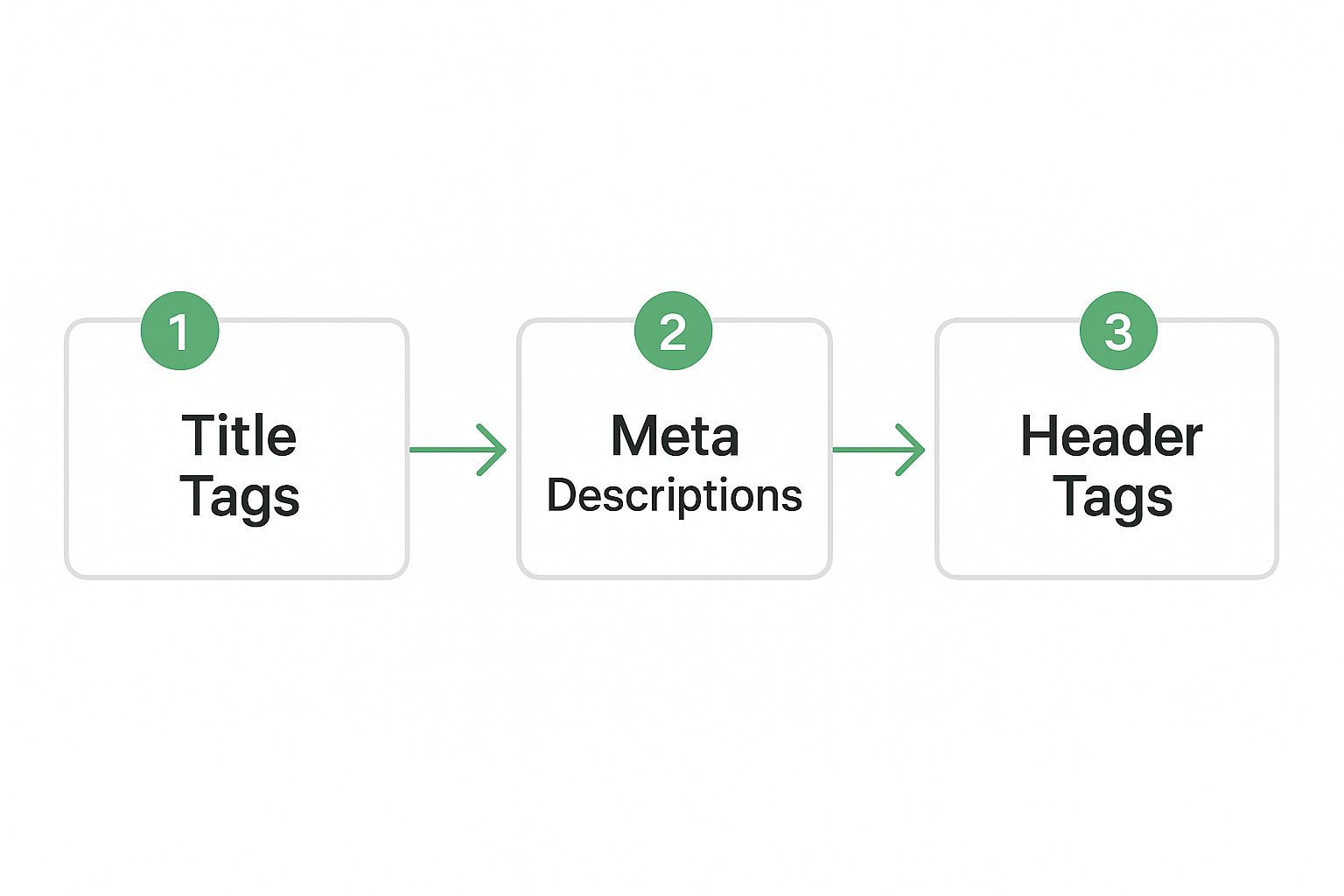
How to Optimize Content for SEO The Definitive Guide
August 23, 2025
Optimizing content for search engines is all about a smart mix of keyword research, thoughtful content structure, and a laser focus on what the reader actually wants. It’s not about gaming the system. It's about creating genuinely high-quality, relevant material that answers a real person's question.
When you get this right, you make it easy for both people and search engines like Google to understand and value what you’ve created.
Laying the Groundwork for SEO Success

Before you even think about firing up a keyword tool or tweaking a single sentence, you need to get the "why" straight. At its heart, good SEO isn't about tricking algorithms—it’s about providing the best possible answer to someone's search query.
That user-first mindset is what powers any winning digital strategy. When you learn how to optimize content for SEO, what you're really learning is how to communicate value more clearly to the people you want to reach.
And the payoff is huge. Organic search is an absolute powerhouse, driving about 33% of all website visits across major industries. The 2025 State of SEO Survey from Conductor also found that a staggering 91% of companies confirmed SEO had a positive impact on their performance and marketing goals.
The Core Pillars of Content Optimization
Understanding the foundational elements gives you a solid framework to build on. Think of it less like a rigid checklist and more like a set of guiding principles that keep you on track. In a way, it’s not so different from other forms of structured writing—our own academic writing style guide shares similar principles about creating clear, organized content.
The real goal here is to create a seamless experience where the user finds exactly what they need, and the search engine recognizes your content as the most helpful, authoritative resource for that specific query.
To give you a clearer picture, here’s a breakdown of how the essential components work together.
Core Pillars of Content Optimization
This table summarizes the essential components you'll need to master for effective SEO content optimization. Each pillar builds on the others to create a comprehensive and user-focused strategy.
| Pillar | Objective | Key Actions |
|---|---|---|
| Keyword Research | Understand audience language and search intent. | Identify primary and secondary keywords, analyze competitor rankings. |
| Content Structure | Improve readability and user experience. | Use clear headings (H2, H3), short paragraphs, and bullet points. |
| On-Page Elements | Signal relevance to search engines. | Optimize title tags, meta descriptions, image alt text, and URLs. |
| Topical Authority | Establish credibility and expertise on a subject. | Create comprehensive content and build a strong internal linking structure. |
By focusing on these four pillars, you ensure that every piece of content you create is not only discoverable but also genuinely valuable to your audience.
Decoding Search Intent and Keywords

Great content isn't just about stuffing keywords into a page. It’s about getting inside a searcher's head and understanding the why behind their query. We call this search intent, and it’s the absolute first thing you need to nail down if you want your content to actually connect with people.
Before you write a single word, you have to figure out what someone really wants when they type something into Google. Are they trying to learn something? Compare a few products? Or are they ready to pull out their credit card? Get this right, and you're building on a solid foundation.
The Four Flavors of Search Intent
Most searches boil down to one of four main motivations. Once you know which one you’re dealing with, you can shape your content's angle, format, and call to action to give people exactly what they came for.
- Informational Intent: The user needs an answer. Think queries that start with "how to," "what is," or "why." A blog post like "How to Repot a Fiddle Leaf Fig" is a perfect match.
- Navigational Intent: The user knows where they want to go. A search for "Natural Write login" isn't an invitation for an article; they just want the login page. Fast.
- Commercial Intent: The user is in research mode, kicking the tires before a potential purchase. Queries like "best running shoes for flat feet" or "Natural Write vs Grammarly" mean they're weighing their options and need reviews or comparisons.
- Transactional Intent: The user is ready to make a move. Searches like "buy Nike Air Max size 10" or "Natural Write free trial" signal a clear desire to complete an action right now.
Failing to match search intent is one of the quickest ways to tank your rankings. If your article is a "how-to" guide but the top search results are all e-commerce pages, Google has already decided that users want to buy, not learn.
Finding and Analyzing Your Keywords
Once you’ve got a handle on intent, it’s time to find the right keywords. The sweet spot is finding phrases with decent search volume that aren't impossible to rank for. You don't even need expensive tools to get started.
Google Trends, for example, is a fantastic free tool. It shows you how popular a search term is over time, which is great for spotting seasonal trends or up-and-coming topics.
This screenshot from Google Trends comparing two keywords says it all.
You can see the obvious seasonal spikes for "winter coats," while "denim jackets" has a much steadier interest year-round. That kind of insight is gold—it tells you when to publish your content for the biggest impact.
From there, you can dig even deeper. Just look at Google's own "People also ask" and "Related searches" sections on the results page. They are a treasure trove of long-tail keywords.
These longer, more specific phrases often have less competition and convert better because they tap into a very specific need. This is becoming even more critical with the rise of voice search, which is all about natural, conversational questions.
We're talking over 1 billion voice searches every month, with 41% of American adults using it daily. Yet, as Exploding Topics points out, only about 13% of marketers are actually optimizing for it. That gap is a massive opportunity. By targeting these detailed questions, you create content that solves a very specific problem—and that’s how you stand out.
Crafting Content That Ranks and Resonates
Okay, so you’ve figured out what people are searching for. Now comes the real work: creating content that actually delivers the goods—for both your audience and the search engines. Great content isn't just about stringing words together. It's about smart structure, building authority, and giving people a fantastic experience from the second they land on your page.
Before you even type a single word, you need a plan. Knowing how to create a content strategy that boosts growth ensures every article you publish serves a bigger purpose.
Think of your article's structure as a roadmap for your reader. Clean headings and a logical flow let people scan and find exactly what they need in seconds. This isn't just a nice-to-have; it's critical. A 2024 First Page Sage study revealed the click-through rate for the #1 spot on Google is a staggering 39.8%. That number plummets to just 18.7% for the second position. If your content is a wall of text, people will bounce, telling Google your page wasn't helpful.
The basic on-page elements that create this structure are fundamental.

As you can see, things like your Title Tag, Meta Description, and Header Tags all work together to signal what your content is about and how it's organized.
On-Page Element Optimization Checklist
Here's a quick checklist to keep you on track as you optimize the most important on-page elements. It’s a simple but effective way to make sure you’ve covered the essentials.
| Element | SEO Best Practice | Impact Level |
|---|---|---|
| Title Tag | Include the primary keyword near the beginning; keep it under 60 characters. | High |
| Meta Description | Write a compelling summary (155-160 characters) that includes the keyword and a call-to-action. | Medium |
| H1 Tag | Use only one H1 per page, featuring your primary keyword. | High |
| H2/H3 Tags | Use for subheadings to structure content; include secondary keywords naturally. | Medium |
| URL Slug | Keep it short, descriptive, and include the primary keyword. | Medium |
| Image Alt Text | Describe the image accurately for accessibility and include relevant keywords. | Low |
| Internal Links | Link to other relevant pages on your site to build topical authority. | Medium |
Following these best practices is a huge step toward creating content that search engines can easily understand and rank.
Building Trust with E-E-A-T
Google is getting much smarter about sniffing out low-quality content. Their quality guidelines now lean heavily on a concept called E-E-A-T, which stands for Experience, Expertise, Authoritativeness, and Trustworthiness. This isn't some technical jargon; it's about proving your content is the real deal.
- Experience: Show you’ve been there. Share personal stories, case studies, or even original photos. If you’re reviewing a product, prove you’ve actually held it in your hands.
- Expertise: Flex your knowledge. Back up your claims with data, link to studies, and explain complex stuff in a way anyone can understand.
- Authoritativeness: Become the person people think of when they have a question in your niche. You build this over time by consistently putting out killer content and earning links from other credible sites.
- Trustworthiness: Just be straight with people. Have a clear author bio, make your contact info easy to find, and make sure your site is secure (HTTPS).
E-E-A-T signals that your content isn't just another generic article—it's a reliable resource from someone who knows what they're talking about. This is how you build an audience that trusts you and keeps coming back for more.
Choosing the Right Content Format
The format you choose has to match the search intent you found earlier. Get this wrong, and your article is dead on arrival. There's a whole toolbox of formats available, and learning how to write compelling content is what makes any of them work.
For example, an informational search like "how to start a vegetable garden" practically screams for a detailed, step-by-step guide. A long-form post with clear H2s for each step, helpful images, and maybe a video would be perfect.
On the other hand, a commercial query like "best project management software" calls for a head-to-head comparison. A simple table comparing features, pricing, and reviews would be incredibly useful because it directly helps the user make a decision. Matching your format to their need is one of the most powerful SEO moves you can make.
Getting On-Page and Technical SEO Right

Even the most brilliant content will get lost if its technical foundation is shaky. This is where the real work of on-page and technical SEO comes in—fine-tuning all the signals that help search engines find, understand, and ultimately rank your pages.
Think of it this way: your content is a killer presentation, but your technical SEO is the projector and mic. If they aren't set up right, nobody's going to hear your message. This covers everything from the words that show up in the search results to how quickly your images load.
Optimizing Your First Impression: Title Tags and Metas
Your title tag and meta description are your elevator pitch on the Google search results page. They're the very first thing a potential reader sees, and getting them right can make a huge difference in your click-through rate.
The trick is to be both descriptive and intriguing. A solid title tag should grab attention and include your main keyword. The meta description then backs it up, telling the searcher exactly why your page is the answer they've been looking for.
This stuff matters more than ever. Google is constantly tweaking things behind the scenes—in fact, it reportedly rewrites titles for 76% of search results. You can't control it completely, but a strong, well-written title gives you the best shot at having your content represented the way you want.
Building Authority with Internal Links and Images
Smart internal linking isn't just about sending users to other pages on your site. It’s about building a web of connections that shows search engines your site's structure and establishes your expertise on a topic. Every link you add passes a little bit of authority and context from one page to another.
For example, if you’re writing about content optimization, it’s a no-brainer to link out to your other guides on keyword research or content strategy. This is how you build a powerful content hub.
Image optimization is another one of those things that’s easy to forget but absolutely critical. Huge, uncompressed images will kill your page speed, and we all know page speed is a non-negotiable ranking factor.
Pro Tip: Always use descriptive alt text for your images. It’s essential for accessibility, but it also gives search engines another clue about what your page is about.
Beyond just the content itself, mastering WordPress speed optimization is a huge piece of the puzzle. A slow site can tank all your other SEO efforts, no matter how great they are.
Speaking Google’s Language with Structured Data
Structured data, also known as schema markup, is like a secret language you can use to talk directly to search engines. It's a standardized format that gives them explicit, detailed information about what’s on your page.
By adding schema, you can tell Google that a string of numbers is actually a product rating, a block of text is a recipe, or your article is a news story. This helps it understand your content on a much deeper level.
The payoff? Rich results. We’re talking about those star ratings, event details, or FAQ dropdowns you see right in the search results. They take up more real estate, grab more attention, and can give your visibility and click-through rates a serious boost.
Measuring Performance to Refine Your Strategy
Publishing a piece of content isn't the finish line. Far from it. That's actually where the real work begins—watching what happens next, figuring out what works, and fixing what doesn't.
If you skip this part, you're just guessing. You have no real way of knowing if all that effort is actually paying off. The key is to stop drowning in data and start focusing on the few metrics that tell you how both Google and your readers are reacting.
The Metrics That Actually Matter for Content Optimization
To get a real feel for your SEO performance, you’ll want to get comfortable with two free, incredibly powerful tools: Google Analytics and Google Search Console. They’re packed with data, but you only need to keep a close eye on a few specific numbers.
Here’s what you should be watching:
- Organic Traffic: This is your bread and butter—the number of people finding you through a search engine. If this number is climbing, you’re on the right track.
- Keyword Rankings: Are you showing up for the terms you're targeting? Google Search Console will show you exactly where you stand and whether you're gaining ground.
- Click-Through Rate (CTR): This one’s a big deal. It tells you what percentage of people who see your page in the search results actually click on it. A low CTR is a huge red flag that your title or meta description isn't compelling enough.
- Bounce Rate: This shows how many visitors leave your site after viewing only one page. A high bounce rate can mean your content isn't what they were looking for, or the page experience just isn't great.
Tracking these consistently helps you connect the dots. For example, if a page is getting tons of impressions but nobody's clicking (low CTR), you know immediately that you need to rewrite that headline. It's a quick fix with a potentially huge payoff. You can find more strategies for this in our guide on measuring content effectiveness.
Why a Content Audit Is Your Secret Weapon
Every article you've already published is an asset. A content audit is just a fancy term for going through all your old posts to see what’s working, what needs a refresh, and what might be better off deleted. This keeps your site from feeling stale and prevents outdated content from damaging your authority.
Learning to optimize content for SEO is a long-term game. But the return is massive. In fact, SEO has one of the best ROIs in marketing, with an organic lead conversion rate of 14.6%. That blows the 1.7% from old-school outbound methods out of the water. Yet, so many businesses don't even track it, as highlighted in some eye-opening SEO ROI statistics. Regularly auditing and updating your content is how you protect and maximize that return.
Start by looking for pages with traffic that’s starting to drop off or rankings that are slipping. Could you add new stats? Update the examples? Maybe just break up a few giant paragraphs? Sometimes, that's all it takes to bring a post back to life and make sure it keeps working for you.
Your Content Optimization Questions, Answered
Even when you have a solid plan, a few nagging questions always seem to surface during the content optimization process. Getting these details right can be the difference between a page that climbs the ranks and one that just sits there. Let's clear up some of the most common hurdles.
How Often Should I Refresh My SEO Content?
There's no magic number here—it really comes down to the topic and how the page is already doing. For your high-performing, evergreen articles, a quick check-in once a year is probably all you need to make sure the information is still on point.
But for content in fast-moving industries like social media or tech, you’ll want to revisit it much more often, maybe even quarterly. The best advice? Let your analytics be your guide. If you see a page slowly bleeding organic traffic or losing its grip on important keyword rankings, that’s your cue to roll up your sleeves and get to work.
A content refresh isn't just about tweaking a few words. It's a chance to add fresh data, swap in better examples, hunt down broken links, and signal to Google that your content is still the most valuable, up-to-date resource out there.
What’s the Right Keyword Density?
Honestly, the whole idea of "keyword density" is a relic from a bygone era of SEO. These days, trying to hit some perfect percentage is a great way to make your content sound robotic and unreadable. That's a huge red flag for search engines and an even bigger turn-off for your audience.
Forget the magic number and think about natural language and topical relevance instead. A much better approach looks like this:
- Smart Placement: Get your main keyword in the most important spots—your title tag, meta description, H1 heading, and somewhere in the first paragraph.
- Use Variations: Naturally weave in synonyms and related phrases (think LSI keywords) throughout your subheadings and body copy.
- Write for Humans First: Your real goal is to cover the topic so thoroughly and clearly that a human reader walks away satisfied. If it reads well and covers all the bases, you've nailed it.
Can I Rank for a Keyword if It's Not in My Title?
Technically, maybe. But you'd be making things incredibly hard on yourself. Your title tag is one of the most powerful on-page signals you have. It's the first thing both people and search crawlers look at to figure out what your page is all about.
Leaving your primary keyword out of the title sends a confusing, weak signal to search engines about what you're trying to rank for. The best practice is simple: always include your main target keyword, or a very close version of it, right there in the title. It gives your content the best possible shot at ranking well.
Ready to turn your AI drafts into polished, human-sounding content that actually ranks? Natural Write instantly refines robotic text, helping it fly past AI detectors and truly connect with your readers. Perfect your SEO content with a single click at https://naturalwrite.com.


